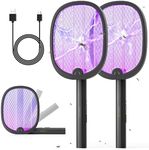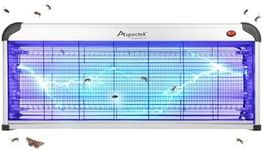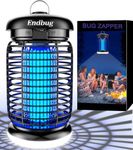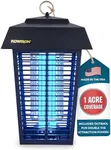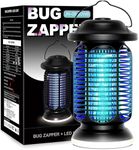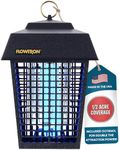Buying Guide for the Best Mosquito Zappers
Choosing the right mosquito zapper can make your indoor or outdoor spaces much more comfortable, especially during warmer months when mosquitoes are most active. The key is to match the zapper’s features to your specific needs, such as the size of the area you want to protect, whether you need it for indoor or outdoor use, and your preferences for maintenance and safety. Understanding the main specifications will help you make a smart choice that keeps your environment mosquito-free.Coverage AreaCoverage area refers to the maximum space the mosquito zapper can effectively protect from mosquitoes. This is usually measured in square feet or meters. It's important because a zapper that's too small for your space won't be effective, while one that's too large may be unnecessary. Small coverage (up to 500 sq ft) is suitable for bedrooms or small patios, medium coverage (500-1500 sq ft) works for larger rooms or decks, and large coverage (over 1500 sq ft) is best for big yards or open spaces. To pick the right one, consider where you'll use it most and choose a zapper that matches or slightly exceeds that area.
Power SourceThe power source determines how the zapper operates—common options are plug-in electric, battery-powered, or solar-powered. This matters because it affects where and how you can use the zapper. Plug-in models are reliable for continuous use indoors or near outlets, battery-powered ones offer portability for camping or areas without electricity, and solar-powered zappers are eco-friendly and great for outdoor use where sunlight is available. Think about where you’ll place the zapper and how often you’ll move it to decide which power source fits your lifestyle.
Type of AttractionMosquito zappers attract insects using different methods, such as UV light, heat, or chemical lures. This is important because some methods are more effective for certain mosquito species or environments. UV light is common and works well in dark or shaded areas, while heat and chemical lures can attract mosquitoes even in daylight or when there are competing light sources. If you’re using the zapper indoors, UV light is usually enough, but for outdoor or high-mosquito areas, a combination of attraction methods may be more effective.
Safety FeaturesSafety features include protective grids, childproof designs, and automatic shut-off functions. These are crucial if you have children or pets, or if the zapper will be placed in high-traffic areas. Protective grids prevent accidental contact with the electric parts, while automatic shut-off can add peace of mind. If safety is a concern in your household, prioritize zappers with robust safety features.
Ease of CleaningEase of cleaning refers to how simple it is to remove dead insects and maintain the zapper. Some models have removable trays or washable parts, making maintenance quick and hygienic. This is important because a zapper that’s hard to clean can become less effective and even unhygienic over time. If you prefer low-maintenance products, look for zappers with easy-access trays or parts that can be rinsed under water.
Noise LevelNoise level describes how much sound the zapper makes during operation, especially when it zaps insects. Some people find the zapping sound bothersome, while others don’t mind. If you plan to use the zapper in bedrooms, living rooms, or quiet outdoor spaces, look for models advertised as low-noise or silent. For outdoor or less sensitive areas, noise may not be a big concern.



